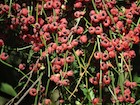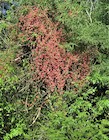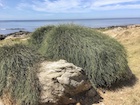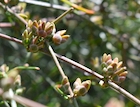
Ripe, seed-bearing cones on a plant in habitat, Argentina. iNaturalist observation 142715626 [Gustavo Puente, 2022.11.23].

An epiphytic plant in habitat, Argentina. iNaturalist observation 142715626 [Gustavo Puente, 2022.11.23].

A plant in habitat on the seashore, Uruguay. iNaturalist observation 38182689 [Santiago, 2020.02.01].

Fertile pollen cones on a plant in habitat, Uruguay. iNaturalist observation 96367121 [Guillermo Menéndez, 2021.09.26].

Developing seed cones on a plant in habitat, Argentina. iNaturalist observation 139157273 [Nahuel, 2022.10.17].

Stems, twigs, and ripe seed cones on a plant in habitat, Uruguay. iNaturalist observation 66996375 [Andrès Costa, 2020.11.18].

Ephedra tweedieana
C.A. Meyer 1846
Common names
Tweedie's jointfir, pico de loro [Spanish].
Taxonomic notes
Syn. Ephedra scandens Miers.
Molecular analysis has found E. rupestris, E. triandra and E. tweedieana to comprise a basal clade sister to the other South American species of Ephedra (Rydin and Korall 2009).
There is some ambiguity about the original publication. The 1847 edition of the Bulletin de la Classe Physico-Mathematique de l'Academie Imperiale des Sciences de Saint-Pétersbourg contains a very brief description by C.A. Meyer in a "Memoire" dated 10 October 1845, but the 1846 edition of the Mémoires de l'Académie impériale des sciences de St.-Pétersbourg contains a full description. So, the 1845 "Mémoire" was not published until 1847, although it was written before the 1846 description. I cite both sources here.
Description
The plants are unmistakable, once identified as Ephedra, for their lax, flexible branching, frequently epiphytic habit, and occurrence in mesic settings. In more detail, they are monoecious shrubs, often epiphytes, with lax flexible branches; catkins sitting at the joints of the branches; two-flowered female catkins; sheath-like leaves that are overlapping and deeply (beyond the middle part) bifid. There is a similarity to E. americana, with which it may occur, but E. tweedieana differs in being dioecious, having loose, bending branches, bearing sessile male and female catkins, and leaves with deeply split sheaths (Meyer 1846).
Distribution and Ecology
Argentina, Brazil, and Uruguay, at elevations of 0-1000 m, in moist forests (including Mata Atlântica) and woods, generally in wetter conditions than other Ephedra (Bell and Bachman 2011, accessed 2021.12.31).
Remarkable Specimens
No data as of 2023.03.03.
Ethnobotany
No data as of 2022.12.31.
Observations
See the observations on iNaturalist, accessed 2021.12.31.
Remarks
The epithet honors Argentine botanist John Tweedie (1775-1862), who collected it near Bahia Blanca, Argentina (Meyer 1846).
Citations
Meyer, C. A. 1846. Versuch einer Monographie der Gattung Ephedra, dirch Abbildung erlautert. Mémoires de l'Académie impériale des sciences de St.-Pétersbourg, Sér. 6, Sci. Math., Seconde Pt. Sci. Nat. 5:96. Available: Biodiversity Heritage Library, accessed 2022.12.31.
Meyer, C. A. 1847. Bulletin de la Classe Physico-Mathematique de l'Academie Imperiale des Sciences de Saint-Pétersbourg 5:36. Available: Biodiversity Heritage Library, accessed 2022.12.31.
Rydin, C., and P. Korall. 2009. Evolutionary relationships in Ephedra (Gnetales), with implications for seed plant phylogeny. International Journal of Plant Sciences 170(8):1031–1043. doi:10.1086/605116.
See also
Luz, C. F. P. D. 2016. Pollen grains of Ephedra tweedieana C.A.Mey., recent species of the Ephedraceae in Brazil. Grana 55:17–23. doi:10.1080/00173134.2015.1057520.
Species profile at Plants of the World Online, accessed 2021.12.31.






